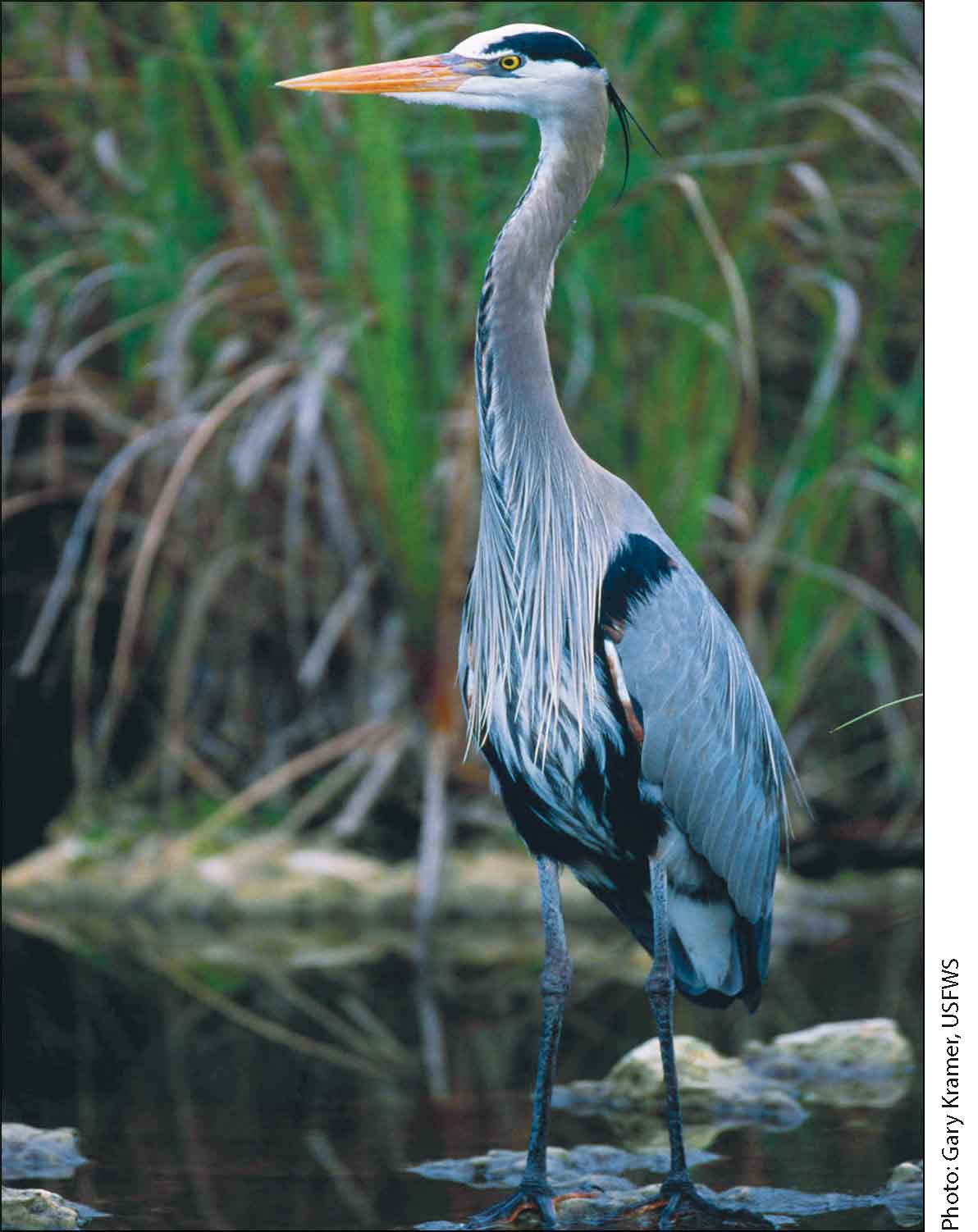Great Blue Herons
Great Blue Herons are large blue-gray birds with long, yellow legs and a long, yellow bill. They have a white head with a black plume stripe reaching from the eye to the back of head. They have shaggy feathers on their neck and back. Their head-to-tail length can push 55 inches and their wingspan can almost reach 75 inches. Great Blue Herons feed primarily on fish, but they will eat whatever is available including aquatic insects, crayfish, small birds, amphibians, reptiles, rodents, and other small mammals. Herons stalk and locate their food by sight. They quickly lunge and stab the prey with their bill. Then, they usually swallow it whole. Great Blue Herons are found across Indiana along any freshwater source. They can usually be seen by small streams, rivers, wetlands, lakes, and ponds. They will even use urban retention ponds and backyard goldfish ponds.
Great Blue Herons usually nest in trees near water with other herons in a colony. They build a stick nest and line it with grass, pine needles, moss, or other dried plant material. Nesting colonies are associated with wetland habitats or larger rivers or streams. Despite their statewide distribution, Great Blue Herons are generally considered a rare or uncommon nester with more colonies in the northern part of the state where more wetland habitat exists. Former Indiana DNR nongame bird biologist, John Castrale, counted over 6,300 nests in Indiana during a 1993 survey of Indiana colonies. The size of the colonies ranged from 2 to 562 nests.
Observations of Great Blue Herons during the Breeding Bird Survey have declined somewhat in recent years. Conservation efforts that benefit these birds focus on nesting habitat and reducing or eliminating impacts to nesting. Human disturbance can cause nest site abandonment, although the effects depend on a number of factors including type and frequency of disturbance, stage of nesting cycle, colony size and the surrounding land uses. Great Blue Herons nest relatively early in the nesting season with pair formation during mid-February to mid-March in Indiana. The complete nesting cycle will continue through June. Human activities should be minimized around rookeries during the entire nesting season, but abandonment is more likely before young are present during pair formation, nest construction, or egg laying.
While Indiana-specific guidelines are lacking, those developed by other states should benefit herons (see Box 1). Regardless, Indiana woodland owners and others working in the woods who encounter a Great Blue Heron rookery should follow some common-sense rules. First and foremost, avoid disturbance during the nesting season which already ongoing. Moving forward, most activities within the buffer zones won’t cause issues outside of the nesting season. Habitat modification, construction, or similar activities should be avoided near nests at all times. If you have a rookery on your land, consider yourself lucky! Following a few simple steps will help provide habitat for these amazing birds in the future.
Brian MacGowan is an Extension Wildlife Specialist with Purdue University’s Department of Forestry. He also has served as secretary and editor for the Woodland Steward since 2008.
The Vermont Fish and Wildlife Department published the following guidelines on protecting Great Blue Heron nesting habitat1.
Primary buffer zone: within 300 feet of the rookery perimeter:
There should be no habitat modification, such as timber cutting, land clearing, and construction of roads, trails, or buildings. Only actions deemed necessary for improving the nesting habitat should be undertaken. All human use of this buffer area should be avoided during the nesting period. Recreational activities such as hiking, hunting, fishing, biking, and camping are compatible with protecting heron nest habitat outside the nesting period.
Secondary buffer zone: from 300 to 650 feet of the rookery perimeter:
There should be no sand or gravel extraction, land clearing, or construction of permanent structures or roads. Existing farming operations including maple sugaring, and use of existing footpaths by non-motorized traffic are allowed during the nesting period. Activities compatible with protecting heron nest habitat outside the nesting period include hunting, fishing, hiking, biking, camping, maintenance of existing roads or trails, and selective timber harvest.
Tertiary buffer zone: from 650 to 1300 feet from the rookery perimeter:
Construction of small buildings, temporary roads, or timber harvesting may be feasible outside of the nesting period with the consultation of a wildlife biologist or professional forester. Activities such as hunting, fishing, hiking, and camping may occur in this zone.
1 Vermont Fish and Wildlife Department. 2002. Guidelines for protection & mitigation of impacts to great blue heron rookeries in Vermont, 13pp.
